HLT Case Study: Clinical Decision-Making and Pathophysiology
VerifiedAdded on 2023/04/22
|5
|1221
|237
Case Study
AI Summary
This case study analyzes the clinical manifestations of a patient named Bea, focusing on how pathophysiology informs clinical decision-making using the Situated Clinical Decision-Making Framework. The analysis covers symptoms like a swollen leg, purulent wound, dyspnea, and diaphoresis, linking them to potential underlying conditions such as edema, thrombosis, congestive heart failure, menopause, and diabetes. The family's background, including drug use and social issues, is considered as a contributing factor to Bea's health problems. The case study highlights the importance of experience, competence, and a comprehensive understanding of pathophysiology in nursing practice, emphasizing the need for quality patient care through informed clinical decisions and consultation with experienced professionals. The impact of social determinants like poverty and substance abuse on healthcare is also discussed.
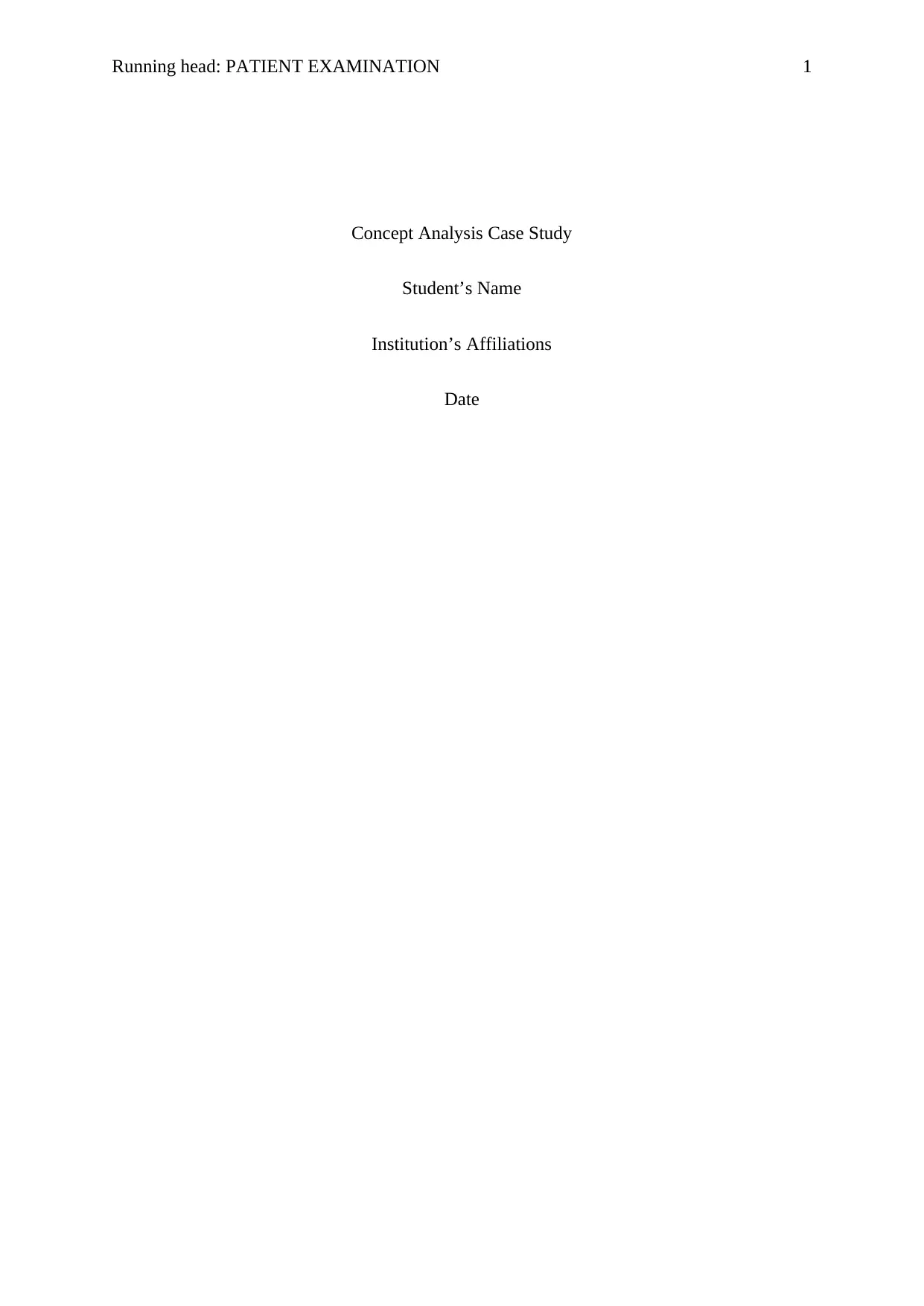
Running head: PATIENT EXAMINATION 1
Concept Analysis Case Study
Student’s Name
Institution’s Affiliations
Date
Concept Analysis Case Study
Student’s Name
Institution’s Affiliations
Date
Paraphrase This Document
Need a fresh take? Get an instant paraphrase of this document with our AI Paraphraser
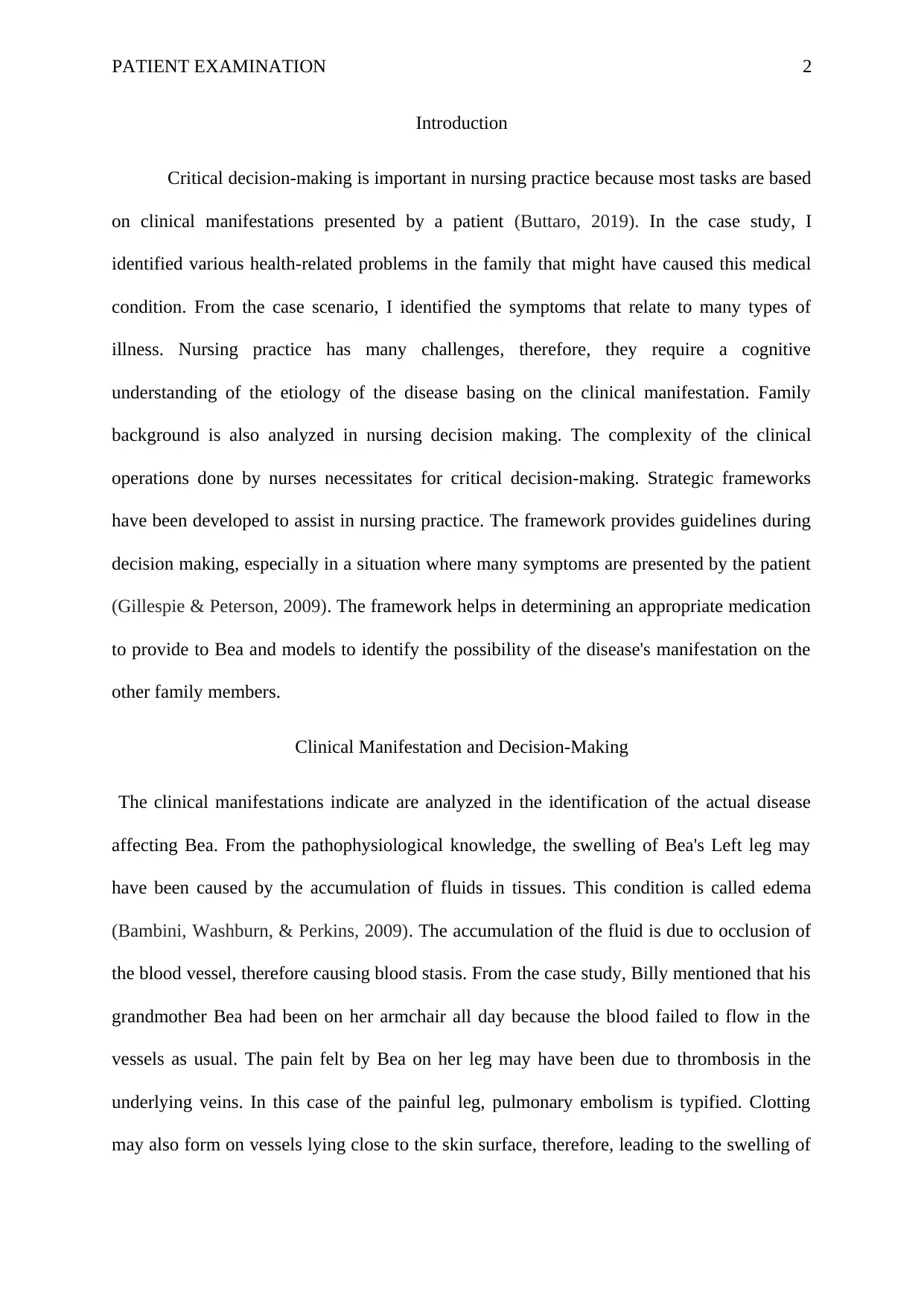
PATIENT EXAMINATION 2
Introduction
Critical decision-making is important in nursing practice because most tasks are based
on clinical manifestations presented by a patient (Buttaro, 2019). In the case study, I
identified various health-related problems in the family that might have caused this medical
condition. From the case scenario, I identified the symptoms that relate to many types of
illness. Nursing practice has many challenges, therefore, they require a cognitive
understanding of the etiology of the disease basing on the clinical manifestation. Family
background is also analyzed in nursing decision making. The complexity of the clinical
operations done by nurses necessitates for critical decision-making. Strategic frameworks
have been developed to assist in nursing practice. The framework provides guidelines during
decision making, especially in a situation where many symptoms are presented by the patient
(Gillespie & Peterson, 2009). The framework helps in determining an appropriate medication
to provide to Bea and models to identify the possibility of the disease's manifestation on the
other family members.
Clinical Manifestation and Decision-Making
The clinical manifestations indicate are analyzed in the identification of the actual disease
affecting Bea. From the pathophysiological knowledge, the swelling of Bea's Left leg may
have been caused by the accumulation of fluids in tissues. This condition is called edema
(Bambini, Washburn, & Perkins, 2009). The accumulation of the fluid is due to occlusion of
the blood vessel, therefore causing blood stasis. From the case study, Billy mentioned that his
grandmother Bea had been on her armchair all day because the blood failed to flow in the
vessels as usual. The pain felt by Bea on her leg may have been due to thrombosis in the
underlying veins. In this case of the painful leg, pulmonary embolism is typified. Clotting
may also form on vessels lying close to the skin surface, therefore, leading to the swelling of
Introduction
Critical decision-making is important in nursing practice because most tasks are based
on clinical manifestations presented by a patient (Buttaro, 2019). In the case study, I
identified various health-related problems in the family that might have caused this medical
condition. From the case scenario, I identified the symptoms that relate to many types of
illness. Nursing practice has many challenges, therefore, they require a cognitive
understanding of the etiology of the disease basing on the clinical manifestation. Family
background is also analyzed in nursing decision making. The complexity of the clinical
operations done by nurses necessitates for critical decision-making. Strategic frameworks
have been developed to assist in nursing practice. The framework provides guidelines during
decision making, especially in a situation where many symptoms are presented by the patient
(Gillespie & Peterson, 2009). The framework helps in determining an appropriate medication
to provide to Bea and models to identify the possibility of the disease's manifestation on the
other family members.
Clinical Manifestation and Decision-Making
The clinical manifestations indicate are analyzed in the identification of the actual disease
affecting Bea. From the pathophysiological knowledge, the swelling of Bea's Left leg may
have been caused by the accumulation of fluids in tissues. This condition is called edema
(Bambini, Washburn, & Perkins, 2009). The accumulation of the fluid is due to occlusion of
the blood vessel, therefore causing blood stasis. From the case study, Billy mentioned that his
grandmother Bea had been on her armchair all day because the blood failed to flow in the
vessels as usual. The pain felt by Bea on her leg may have been due to thrombosis in the
underlying veins. In this case of the painful leg, pulmonary embolism is typified. Clotting
may also form on vessels lying close to the skin surface, therefore, leading to the swelling of
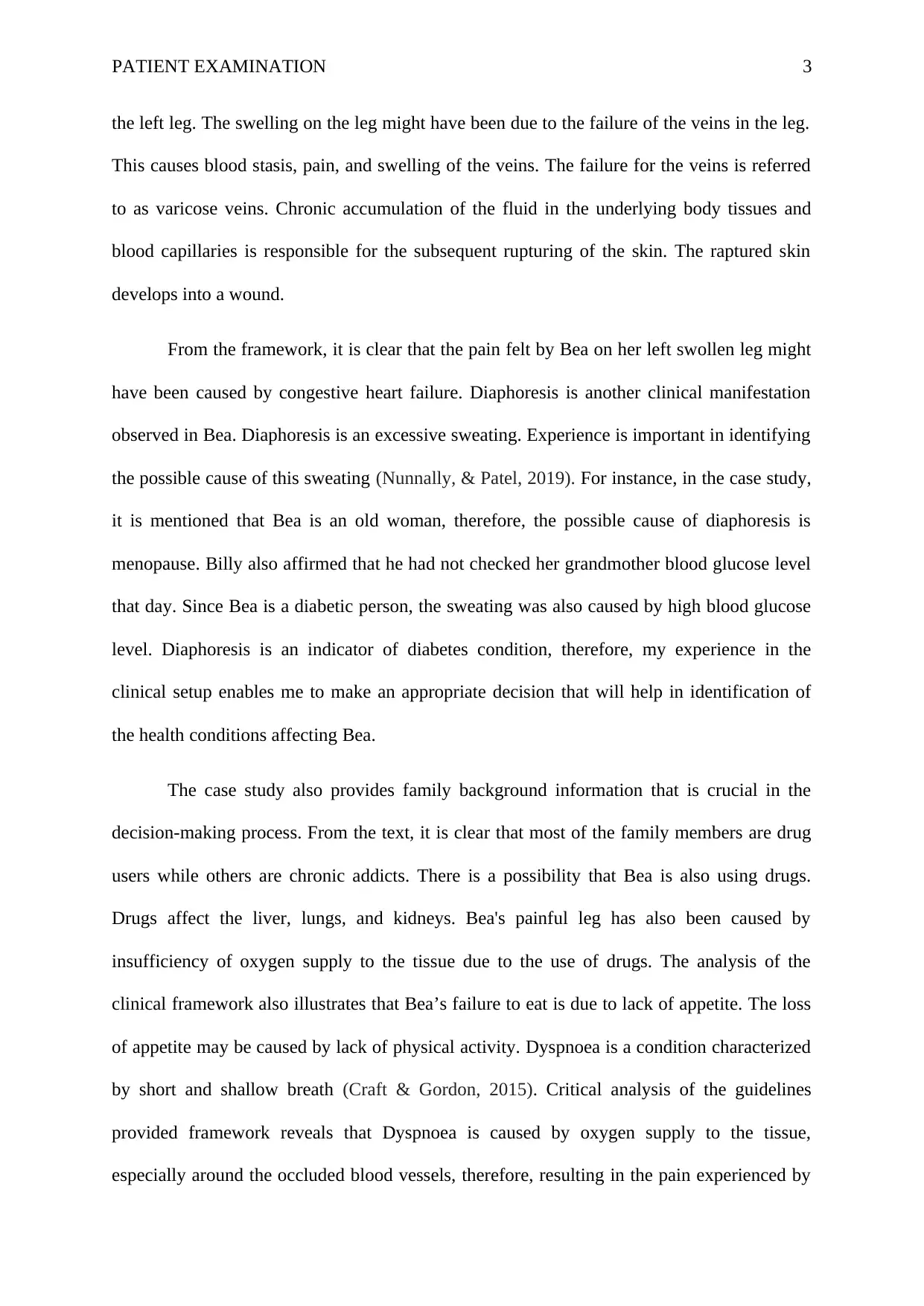
PATIENT EXAMINATION 3
the left leg. The swelling on the leg might have been due to the failure of the veins in the leg.
This causes blood stasis, pain, and swelling of the veins. The failure for the veins is referred
to as varicose veins. Chronic accumulation of the fluid in the underlying body tissues and
blood capillaries is responsible for the subsequent rupturing of the skin. The raptured skin
develops into a wound.
From the framework, it is clear that the pain felt by Bea on her left swollen leg might
have been caused by congestive heart failure. Diaphoresis is another clinical manifestation
observed in Bea. Diaphoresis is an excessive sweating. Experience is important in identifying
the possible cause of this sweating (Nunnally, & Patel, 2019). For instance, in the case study,
it is mentioned that Bea is an old woman, therefore, the possible cause of diaphoresis is
menopause. Billy also affirmed that he had not checked her grandmother blood glucose level
that day. Since Bea is a diabetic person, the sweating was also caused by high blood glucose
level. Diaphoresis is an indicator of diabetes condition, therefore, my experience in the
clinical setup enables me to make an appropriate decision that will help in identification of
the health conditions affecting Bea.
The case study also provides family background information that is crucial in the
decision-making process. From the text, it is clear that most of the family members are drug
users while others are chronic addicts. There is a possibility that Bea is also using drugs.
Drugs affect the liver, lungs, and kidneys. Bea's painful leg has also been caused by
insufficiency of oxygen supply to the tissue due to the use of drugs. The analysis of the
clinical framework also illustrates that Bea’s failure to eat is due to lack of appetite. The loss
of appetite may be caused by lack of physical activity. Dyspnoea is a condition characterized
by short and shallow breath (Craft & Gordon, 2015). Critical analysis of the guidelines
provided framework reveals that Dyspnoea is caused by oxygen supply to the tissue,
especially around the occluded blood vessels, therefore, resulting in the pain experienced by
the left leg. The swelling on the leg might have been due to the failure of the veins in the leg.
This causes blood stasis, pain, and swelling of the veins. The failure for the veins is referred
to as varicose veins. Chronic accumulation of the fluid in the underlying body tissues and
blood capillaries is responsible for the subsequent rupturing of the skin. The raptured skin
develops into a wound.
From the framework, it is clear that the pain felt by Bea on her left swollen leg might
have been caused by congestive heart failure. Diaphoresis is another clinical manifestation
observed in Bea. Diaphoresis is an excessive sweating. Experience is important in identifying
the possible cause of this sweating (Nunnally, & Patel, 2019). For instance, in the case study,
it is mentioned that Bea is an old woman, therefore, the possible cause of diaphoresis is
menopause. Billy also affirmed that he had not checked her grandmother blood glucose level
that day. Since Bea is a diabetic person, the sweating was also caused by high blood glucose
level. Diaphoresis is an indicator of diabetes condition, therefore, my experience in the
clinical setup enables me to make an appropriate decision that will help in identification of
the health conditions affecting Bea.
The case study also provides family background information that is crucial in the
decision-making process. From the text, it is clear that most of the family members are drug
users while others are chronic addicts. There is a possibility that Bea is also using drugs.
Drugs affect the liver, lungs, and kidneys. Bea's painful leg has also been caused by
insufficiency of oxygen supply to the tissue due to the use of drugs. The analysis of the
clinical framework also illustrates that Bea’s failure to eat is due to lack of appetite. The loss
of appetite may be caused by lack of physical activity. Dyspnoea is a condition characterized
by short and shallow breath (Craft & Gordon, 2015). Critical analysis of the guidelines
provided framework reveals that Dyspnoea is caused by oxygen supply to the tissue,
especially around the occluded blood vessels, therefore, resulting in the pain experienced by
⊘ This is a preview!⊘
Do you want full access?
Subscribe today to unlock all pages.

Trusted by 1+ million students worldwide
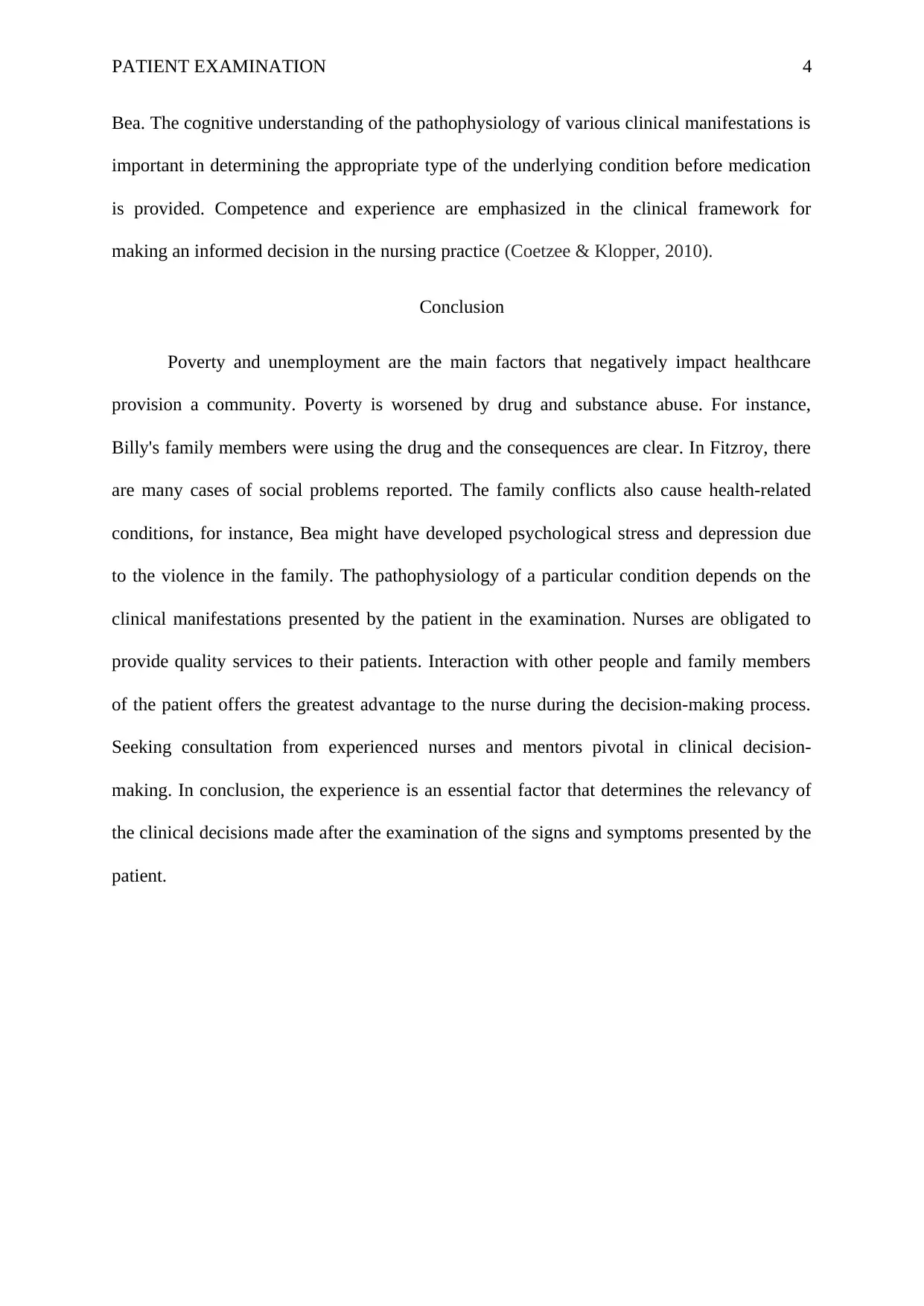
PATIENT EXAMINATION 4
Bea. The cognitive understanding of the pathophysiology of various clinical manifestations is
important in determining the appropriate type of the underlying condition before medication
is provided. Competence and experience are emphasized in the clinical framework for
making an informed decision in the nursing practice (Coetzee & Klopper, 2010).
Conclusion
Poverty and unemployment are the main factors that negatively impact healthcare
provision a community. Poverty is worsened by drug and substance abuse. For instance,
Billy's family members were using the drug and the consequences are clear. In Fitzroy, there
are many cases of social problems reported. The family conflicts also cause health-related
conditions, for instance, Bea might have developed psychological stress and depression due
to the violence in the family. The pathophysiology of a particular condition depends on the
clinical manifestations presented by the patient in the examination. Nurses are obligated to
provide quality services to their patients. Interaction with other people and family members
of the patient offers the greatest advantage to the nurse during the decision-making process.
Seeking consultation from experienced nurses and mentors pivotal in clinical decision-
making. In conclusion, the experience is an essential factor that determines the relevancy of
the clinical decisions made after the examination of the signs and symptoms presented by the
patient.
Bea. The cognitive understanding of the pathophysiology of various clinical manifestations is
important in determining the appropriate type of the underlying condition before medication
is provided. Competence and experience are emphasized in the clinical framework for
making an informed decision in the nursing practice (Coetzee & Klopper, 2010).
Conclusion
Poverty and unemployment are the main factors that negatively impact healthcare
provision a community. Poverty is worsened by drug and substance abuse. For instance,
Billy's family members were using the drug and the consequences are clear. In Fitzroy, there
are many cases of social problems reported. The family conflicts also cause health-related
conditions, for instance, Bea might have developed psychological stress and depression due
to the violence in the family. The pathophysiology of a particular condition depends on the
clinical manifestations presented by the patient in the examination. Nurses are obligated to
provide quality services to their patients. Interaction with other people and family members
of the patient offers the greatest advantage to the nurse during the decision-making process.
Seeking consultation from experienced nurses and mentors pivotal in clinical decision-
making. In conclusion, the experience is an essential factor that determines the relevancy of
the clinical decisions made after the examination of the signs and symptoms presented by the
patient.
Paraphrase This Document
Need a fresh take? Get an instant paraphrase of this document with our AI Paraphraser
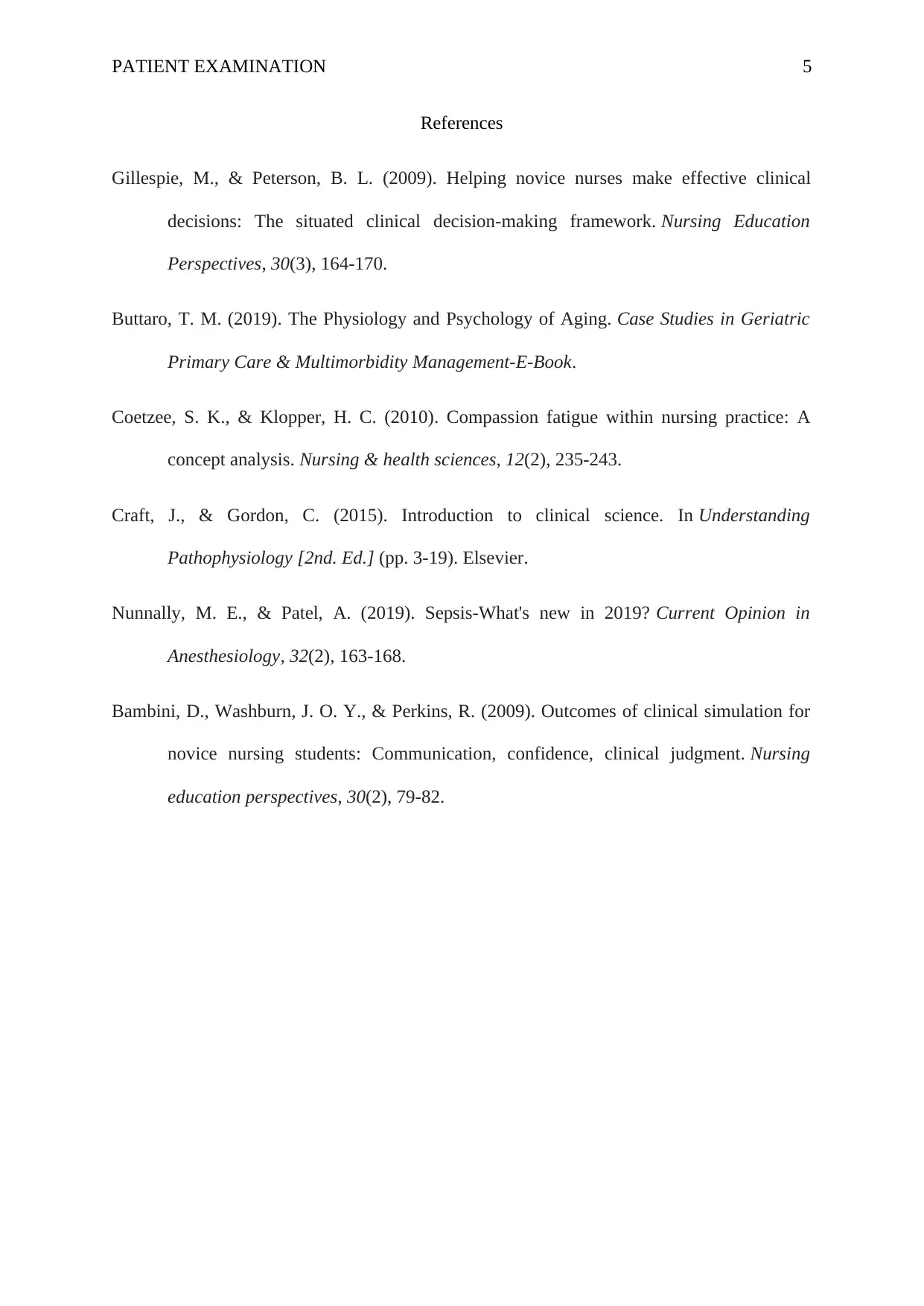
PATIENT EXAMINATION 5
References
Gillespie, M., & Peterson, B. L. (2009). Helping novice nurses make effective clinical
decisions: The situated clinical decision-making framework. Nursing Education
Perspectives, 30(3), 164-170.
Buttaro, T. M. (2019). The Physiology and Psychology of Aging. Case Studies in Geriatric
Primary Care & Multimorbidity Management-E-Book.
Coetzee, S. K., & Klopper, H. C. (2010). Compassion fatigue within nursing practice: A
concept analysis. Nursing & health sciences, 12(2), 235-243.
Craft, J., & Gordon, C. (2015). Introduction to clinical science. In Understanding
Pathophysiology [2nd. Ed.] (pp. 3-19). Elsevier.
Nunnally, M. E., & Patel, A. (2019). Sepsis-What's new in 2019? Current Opinion in
Anesthesiology, 32(2), 163-168.
Bambini, D., Washburn, J. O. Y., & Perkins, R. (2009). Outcomes of clinical simulation for
novice nursing students: Communication, confidence, clinical judgment. Nursing
education perspectives, 30(2), 79-82.
References
Gillespie, M., & Peterson, B. L. (2009). Helping novice nurses make effective clinical
decisions: The situated clinical decision-making framework. Nursing Education
Perspectives, 30(3), 164-170.
Buttaro, T. M. (2019). The Physiology and Psychology of Aging. Case Studies in Geriatric
Primary Care & Multimorbidity Management-E-Book.
Coetzee, S. K., & Klopper, H. C. (2010). Compassion fatigue within nursing practice: A
concept analysis. Nursing & health sciences, 12(2), 235-243.
Craft, J., & Gordon, C. (2015). Introduction to clinical science. In Understanding
Pathophysiology [2nd. Ed.] (pp. 3-19). Elsevier.
Nunnally, M. E., & Patel, A. (2019). Sepsis-What's new in 2019? Current Opinion in
Anesthesiology, 32(2), 163-168.
Bambini, D., Washburn, J. O. Y., & Perkins, R. (2009). Outcomes of clinical simulation for
novice nursing students: Communication, confidence, clinical judgment. Nursing
education perspectives, 30(2), 79-82.
1 out of 5
Related Documents
Your All-in-One AI-Powered Toolkit for Academic Success.
+13062052269
info@desklib.com
Available 24*7 on WhatsApp / Email
![[object Object]](/_next/static/media/star-bottom.7253800d.svg)
Unlock your academic potential
Copyright © 2020–2025 A2Z Services. All Rights Reserved. Developed and managed by ZUCOL.





